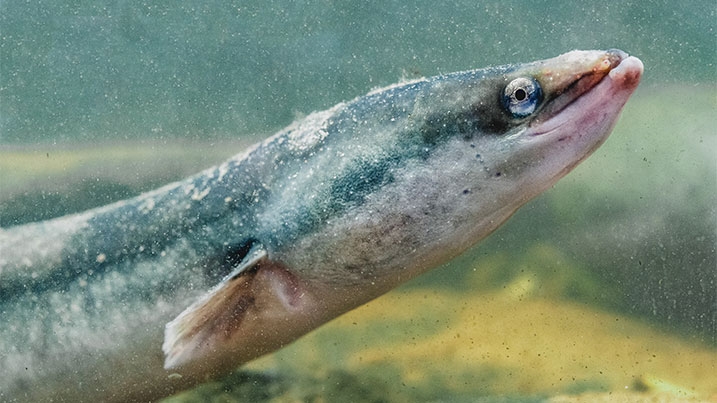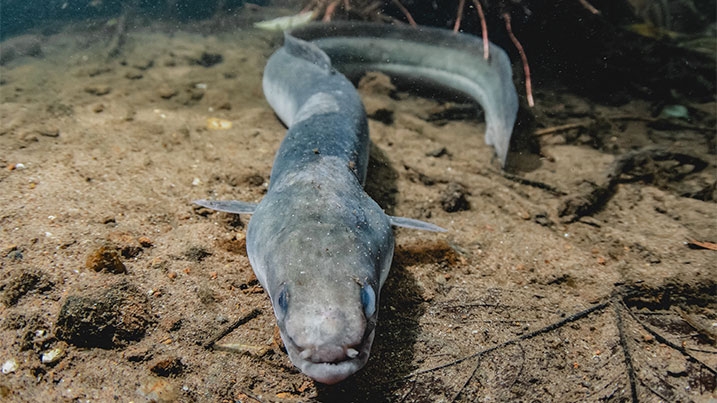European Eel
Scientific name: Anguilla anguilla
With an extraordinary life cycle which starts in the Sargasso Sea near Bermuda and takes it across the Atlantic Ocean to Europe and then back again, the European eel makes one of the most astonishing animal migrations observed in nature. Sadly the number arriving in Europe has fallen by around 95% in the last 40 years.

Species information
- Regarded as critically endangered on the IUCN Red List of Threatened Species.
- Priority species under the UK Post-2010 Biodiversity Framework
- Length: 60-80 cm, although can reach 1.5 m in exceptional cases
- Tail: 9.5-14 cm
- Weight: 1-2 kg (large adult)
- Average lifespan: 20 years, but can live up to 50 years

Appearance
The European eel has five life stages and its appearance changes dramatically for each.
1. Larvae
The European eel lays its eggs in the deep blue waters of the Sargasso Sea. As they hatch into transparent, leaf-shaped larvae they join the Gulf Stream and are carried across the Atlantic
2. Glass eel
Their 4,000 mile drifting journey lasts a year or two and when they reach the shores of Europe and North Africa they metamorphose into finger-length, see-through miniature “glass eels” to continue their journey inland.
3. Elver
As they enter freshwater and migrate upstream, the eels darken in colour. This is an intermediate stage and they’re now known as elvers or bootlace eels.
4. Yellow eel
As they mature in their freshwater habitat, their bellies become yellow and they become known as yellow eels. They can remain in this stage for more than 20 years.
5. Silver eel
Once they’re ready to reproduce, the eels change colour again and are known as silver eels as they migrate back to the Sargasso Sea to spawn.
Where does it Iive?
The European eel can be found in a wide variety of freshwater and estuarine habitats where they spend the majority of their lives. They also spend up to a few years migrating across the Atlantic Ocean to and from their spawning grounds.
What does it eat?
Adult European eels have a broad diet that includes fish, molluscs and crustaceans. They also scavenge on dead fish. The eel is also reported to leave the water and enter fields to feed on slugs and worms. Small eels feed on insect larvae and worms as well as molluscs and crustaceans.
How WWT is helping eels
We’ve been monitoring eels around our reserves for a while now and have noticed a big problem – there are very few young eels living in and around our wetlands. So we’re doing what we can to find out what is causing this and working to make it as easy as possible for young eels to access the important wetland habitats across our reserves.
Eel ladders
At Slimbridge we’re making our reserve as eel friendly as possible. At one access point - a 400 metre tunnel built in Victorian times, we’ve created an ‘eel ladder’ to make it easier for them to make the two metre climb into the tunnel that they can sometimes fact at low tide.
Eel mops
At WWT Castle Espie we’re adopting a different technique. Here the freshwater lagoon is maintained with pipes that have tidal flaps that close at low tide to stop saltwater flowing in. Unfortunately they also stop glass eels as well. To get round the problem we set out collecting devices that look like mop heads to gather the glass eels as they arrive. We then gently carry the young eels in buckets to the freshwater pools on site.
Fish and chips
We’re also tagging our eels with embedded microchips much as you would a pet. This is helping us discover more about their long and complex lives. We’ve installed a scanning device in a ditch at Slimbridge through to be the main thoroughfare the silver eels take as they leave our wetlands for their long migration back to their spawning sites. As each tagged eel wriggles pass the scanner, its departure will be recorded electronically.
Threats to eels
The exact causes of the European eel’s rapid decline over the last 40 years is still poorly understood, but the key threats facing them is: habitat loss and degradation, the construction of dams, reductions in water quality, overfishing (glass eels are a delicacy in many parts of the world), disease and climate change affecting ocean currents and glass eel recruitment. Where and when can you see European eels?
The European eel spends most of its time hidden in the dark waters of rivers, lakes and ditches, but if you’re lucky you might catch a glimpse of a silvery body as thick as your wrist and as long as your arm, gliding by in the wetlands at one of our wetland centres.
How you can help
WWT is one of the largest and most respected wetland conservation charities in the world. In the UK we have ten wetland sites that we manage for the benefit of the wildlife they support. Become a member and get free access all year to explore these extraordinary places while knowing that your membership is also helping us save wetlands and their wildlife in the UK and abroad. Plus you’ll receive exciting updates on our wildlife news, find out about events on your doorstep and be the first to hear about our volunteering opportunities.
Join us